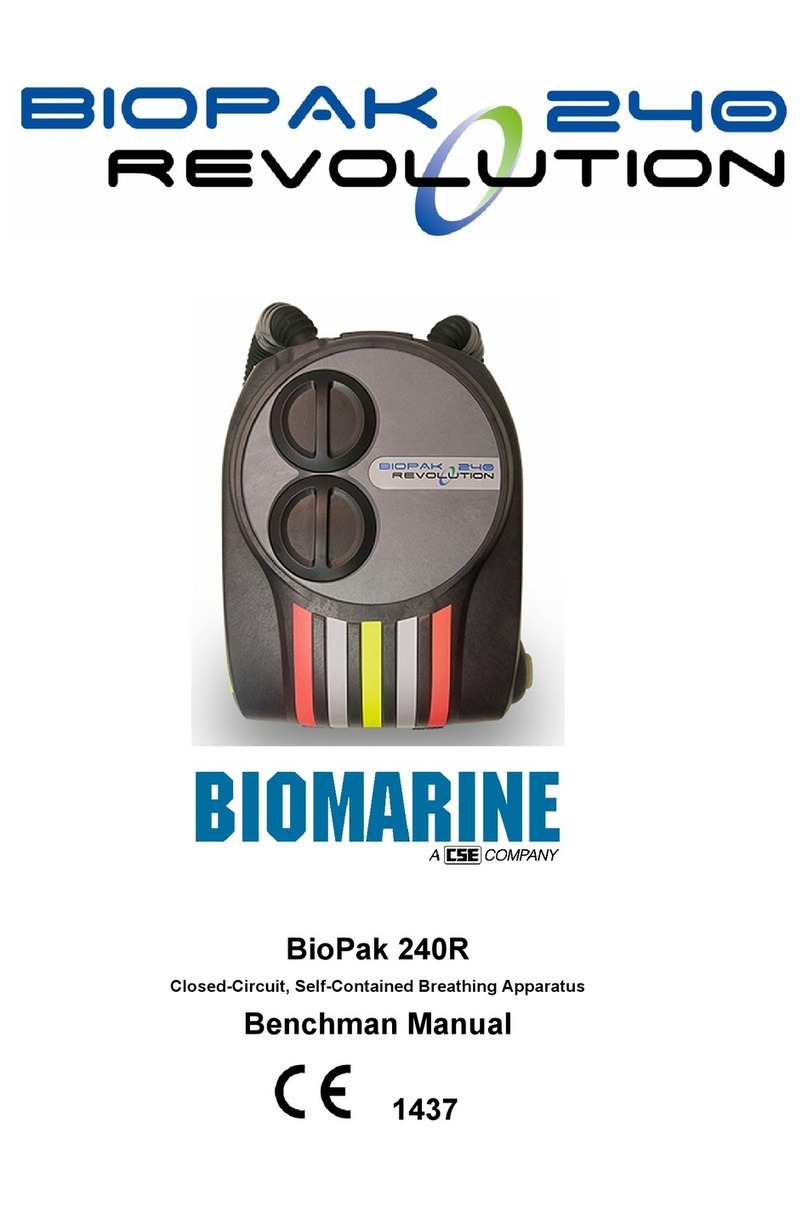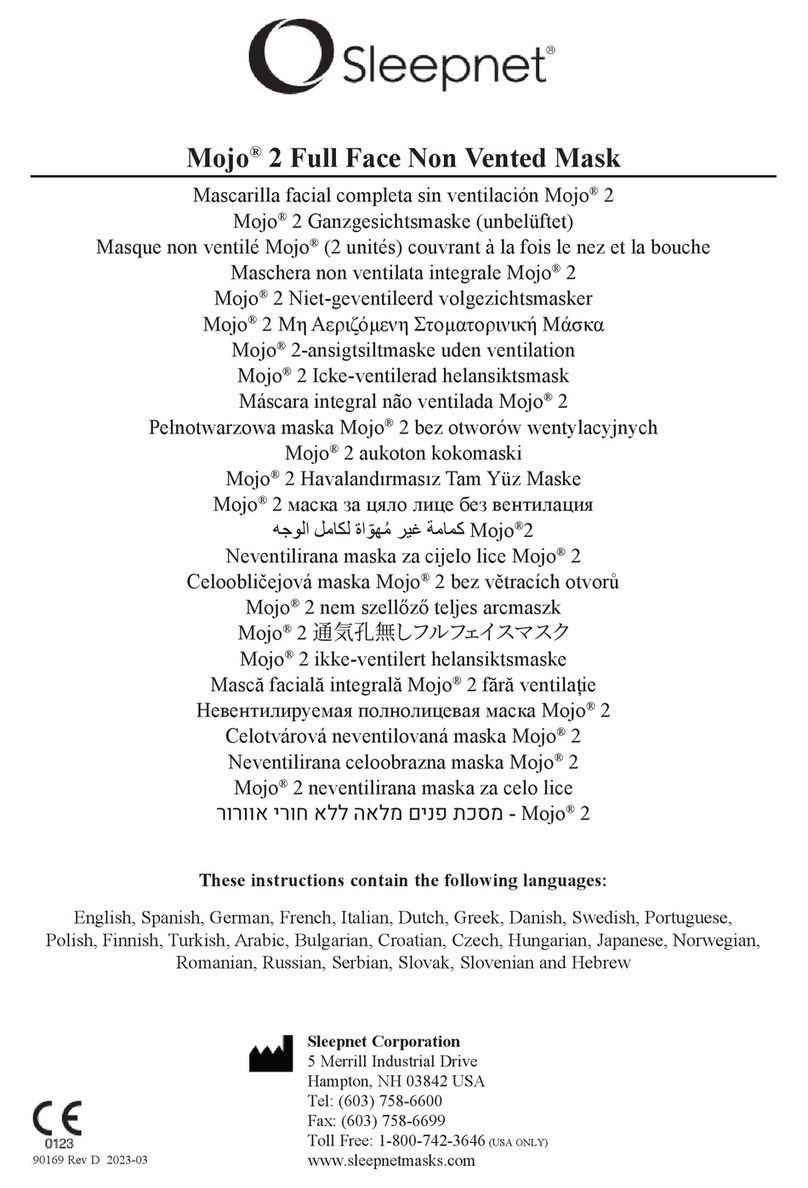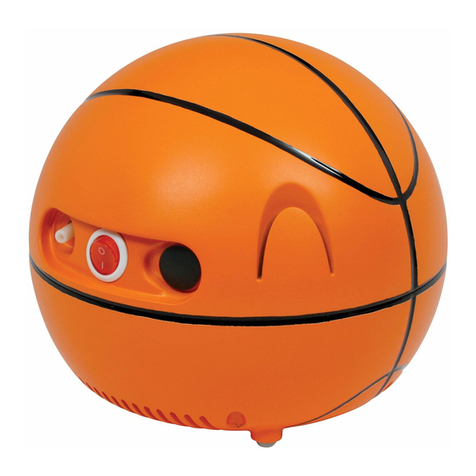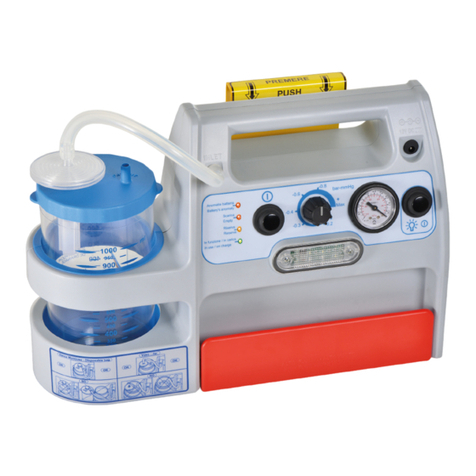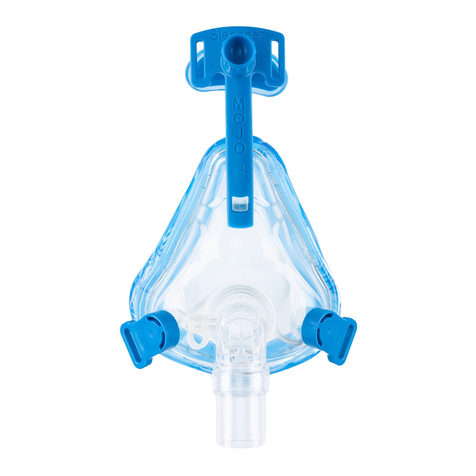CSE BIOMARINE BIOPAK 240-R User manual

A47D256, Revision J
B5-06-6000-22-0
June 2023
BioPak 240R
Closed-Circuit, Self-Contained Breathing Apparatus
User Instructions
1437

BioPak 240R User Instruction Manual
A47D256, Revision J
2
Contents
WARNINGS 3
DISCLAIMER 4
1. INTRODUCTION 5
1.1 Breathable Oxygen 5
1.2 Apparatus Duration 5
1.3 Personnel Training 5
1.4 Servicing 5
1.5 Spare Parts 6
2. APPARATUS DESCRIPTION 7
2.1 General 7
Approval/ Conforming Standards 7
Notified Bodies 7
2.2 Harness 8
2.3 Housing 8
2.4 Breathing Loop 8
2.5 Oxygen Delivery System 8
2.6 Oxygen Cylinder 8
2.7 Alarming System 9
2.8 Facemask 10
2.9 Optional Attachments 10
3. PREPARATION FOR USE 11
3.1 Maintenance Tag Inspection 11
3.2 Mask Preparation 11
3.3 BioPak Positioning 11
3.4 PCM Installation 11
3.5 Carbon Dioxide Scrubber Installation 11
3.6 Breathing Chamber Lid Installation 12
3.7 Coolant Canister Installation 12
4. DONNING THE APPARATUS 13
4.1 Donning the Apparatus 13
4.2 Donning the Facemask 13
4.3 Activate Oxygen Supply 14
5. PRACTICAL USE 15
5.1 Breathing the Apparatus 15
5.2 Speaking 15
5.3 Alarming System 15
5.4 Coolant Replacement 15
5.5 Emergency Bypass 16
5.6 Emergency Operation 16
5.7 Low Temperature Operation 16
5.8 Facemask Fogging 16
6. DOFFING THE APPARATUS 17
6.1 Doffing Instructions 17
7. APPARATUS SPECIFICATIONS 18
DECLARATION OF CONFORMITY 19

BioPak 240R User Instruction Manual
A47D256, Revision J
3
WARNINGS
Please Read Carefully and Fully Understand
This manual is for use by personnel trained in the use and care of compressed oxygen,
closed-circuit breathing apparatus, and MUST NOT be used as a self-teaching guide by
untrained users. Failure to understand or adhere to the BioPak user instructions and BioPak
benchman manual may result in injury or death.
Biomarine Inc. has taken great care to ensure that the information in the manual is accurate,
complete and clear. However, Training & Technical Support Services will be pleased to
clarify any points in the manual and answer questions on Biomarine breathing apparatus.
The following warnings are in accordance with certifying authority requirements and
apply to the use of breathing apparatus in general:
•Breathing apparatus user must be fully trained in the use and care of closed-
circuit, self-contained, compressed oxygen breathing apparatus.
•Ensure that the selection of the apparatus type is sufficient for the tasks being
undertaken and the hazards likely to be encountered. Please refer to National
Regulations for guidance.
•Adequate protection may not be provided in certain highly toxic atmospheres.
•The apparatus must be tested and serviced in accordance with the BioPak 240R
Benchman Manual. All cleaning, disinfection and service must be performed by
a trained Benchman as specified in the Benchman’s Manual (A47D257).
•The quality of oxygen used to supply and charge the breathing apparatus must
be medical or aviation grade oxygen with a moisture content less than 50 mg/m3
at 207 bar.
•Ensure that a good seal can be obtained between the face and facemask. The
wearing of beards, side-burns or spectacles may adversely affect the sealing of
a facemask to the wearer’s face.
•The apparatus is not designed for use as an underwater diving rebreather.
•The harness must not be used as a vehicle seat or fall arrest restraint.
•Replacement of the alarm system battery shall be performed in area
atmospheres known to be safe and non-explosive.
•The improper use of closed-circuit breathing apparatus carries a risk of carbon
dioxide poisoning of user. Users shall be fully trained in recognizing the effects
of carbon dioxide poisoning.
•Carbon Dioxide Scrubbers must be stored at a temperature between 4oC and
32oC to prevent degradation of the absorbent material.
•Carbon Dioxide Scrubbers must be utilized with the supplied Moisture Pad to
prevent scrubber canister flooding that may lead to elevated carbon dioxide
levels in the breathing gas.
•Oxygen Cylinder Marking Warning: Any additional label added by outside
parties, such as hydro-testing facilities or the end user, shall not cover the
existing manufacturer cylinder label or damage the exterior coating of the
cylinder.

BioPak 240R User Instruction Manual
A47D256, Revision J
4
DISCLAIMER
Failure to comply with these instructions or misuse of the apparatus may result in:
death, injury or material damage, and invalidate any warranty or insurance claims.
This manual presents the minimum requirements for BioPak utilization.

5
1. INTRODUCTION
1.1 Breathable Oxygen
Oxygen used to supply or charge the
breathing apparatus must be medical or
aviation grade oxygen with moisture
content less than 50 mg/m3at 207 bar.
The composition of suitable oxygen is
given below and provides the maximum
level of contaminates in the source oxygen
acceptable for use in the BioPak.
Oxygen: 99.5% minimum mole
Carbon Dioxide: 300 ppm maximum
Carbon Monoxide: 10 ppm maximum
The purity/quality of oxygen used to supply
and charge breathing apparatus should be
tested periodically in accordance with
national regulations.
National regulations must be observed.
Personnel dealing with compressed
oxygen and compressed oxygen cylinders
must be fully trained in the use and
handling of compressed oxygen.
1.2 Apparatus Duration
The apparatus will provide the user with
440 liters of compressed oxygen and has
been rated for a 4-hour duration based
upon machine testing at a breathing rate
of 30 liters/minute according to
specifications of EN145. Actual duration
of the apparatus will vary due to factors
such as:
•Workload: high work rates will
increase consumption rates of
oxygen.
•Facemask Seal: poor seal of
mask will result in system leaks
and high oxygen consumption
rates.
•Physical Fitness of Wearer
•System Leaks: leaks in the
BioPak system will result in high
oxygen consumption.
It is important that all wearers are aware of
the above factors when assessing BioPak
duration.
It is equally important that all wearers
understand that the BioPak 240R
respirator is a positive-pressure apparatus.
Leaks in the apparatus itself or in the seal
between the wearer’s face and the
facemask will lead to the apparatus adding
additional oxygen to maintain positive
pressure.
1.3 Personnel Training
Personnel who use closed-circuit, self-
contained, positive-pressure, compressed
oxygen breathing apparatus must be fully
trained in accordance with these
instructions and national regulations.
These instructions cannot replace an
accredited training course provided by
qualified instructors in the proper and safe
use of Biomarine breathing apparatus.
Please contact Training & Technical
Support Services or your local distributor
for training course details.
1.4 Servicing
The BioPak 240R must be serviced at
scheduled intervals by qualified benchmen
personnel who have completed a formal
training course and hold a current
certificate for the service and repair of
Biomarine breathing apparatus.
Turn Around Maintenanceshall be
performed after each use of the BioPak
240R as detailed in the BioPak 240R
Benchman Manual.
Long Term Maintenance must be
performed on a monthly basis, if the
BioPak is in constant use; or, on a
quarterly basis if the BioPak is being used
less than once per month, as defined in
the BioPak 240R Benchman Manual.
RMS Battery Replacement Procedure
must be followed as defined in the BioPak
240R Benchman Manual.
Benchman training and service contracts
can be provided by contacting Training &
Technical Support Services.

BioPak 240R User Instruction Manual
A47D256, Revision J
6
1.5 Spare Parts
Spare parts, accessories, general
information and factory service can be
obtained by contacting Training &
Technical Support Services.
Reference details are provided in the
BioPak 240R Benchman Manual
concerning spare part identification,
accessory identification and BioPak
factory service.
Training & Technical Support Services:
Biomarine Inc.
A Wholly Owned Subsidiary of CSE
Corporation
1001 Corporate Lane, Suite 240
Export, PA 15632
United States of America
Tel: +1 412.856.9200
Fax: +1 412.856.9203
Web: Biomarineinc.com
•Customers can also contact their
local authorized Biomarine
Distributor for training, product
support, emergency support or
maintenance.
•The BioPak 240R-NIOSH User
and Benchman manuals can be
provided in electronic format upon
request.
•Reference documentation
supplied with sales order for
standard terms of warranty.
•Training posters, manuals, SDS
data and other training materials
are available for download from
the Biomarine website.

BioPak 240R User Instruction Manual
A47D256, Revision J
7
2. APPARATUS DESCRIPTION
2.1 General
BioPak 240R is a closed-circuit, positive-
pressure, self-contained breathing
apparatus (CCBA) for use in long-duration
missions into atmospheres that are
immediately dangerous to life and health
(IDLH). The BioPak 240R is designed to
provide respiratory protection ((EU)
2016/425 Annex II, 3.10.1) protecting
against hazardous substances and
mixtures and/or insufficient oxygen
atmosphere as outlined in category III of
Annex I of (EU) 2016/425 and meets the
requirements of EN 145 for 4P/O2
protection. Applications include mine
rescue, fire-fighting, confined space entry,
domestic preparedness, military, tunnel
rescue and HAZMAT
All versions of the BioPak 240R feature a
backpack-style housing that is worn over
the shoulders and hips of the wearer. A
pressure gauge is supplied to indicate
remaining stores of oxygen and two visual
alarms and one audible alarm is provided
for system status.
The closed-circuit design will recycle the
wear’s exhalation breath by removing
carbon dioxide, replacing consumed
oxygen, trapping condensation and
cooling the breathing gas.
The positive-pressure design will maintain
internal breathing gas pressures slightly
above external atmospheric pressure.
This feature will provide increased
protection against the inward migration of
external toxins to the wearer.
All external housing components are static
dissipative and flame retardant.
BioPak 240R is approved and conforms to
the following European Standards:
•EN 136:1998 Respiratory Protective
Devices - Full Face Masks
•EN 145:1997 Respiratory Protective
Devices – Self-contained, Closed-
circuit Breathing Apparatus
Compressed Oxygen Type
•Directive 2014/68/EU Pressure
Equipment
•EN 60079-0:2018 Explosive
Atmospheres-Equipment General
Requirements
•EN 60079-11:2023 Explosive
Atmospheres-Equipment Protection by
Intrinsic Safety “I”
•EN 60079-26:2021 Explosive
Atmospheres. Equipment with
Equipment Protection Level (EPL) Ga
•EN 50303:2000 Group 1, Category M1
Equipment Intended to Remain
Functional in Atmospheres
Endangered by Firedamp and/or Coal
Dust
•IEC 60079-0:2018 Edition:7.0
Explosive Atmospheres – Part 0:
General Requirements
•IEC 60079-11:2023 Edition:7.0
Explosive Atmospheres – Part 11:
Equipment Protection by Intrinsic
Safety “I”
•2014/34/EU ATEX Directive
BioPak 240R is “CE” marked in
accordance with REGULATION (EU)
2016/425 OF THE EUROPEAN
PARLIAMENT AND OF THE
COUNCIL of 9 March 2016 on
personal protective equipment.
BioPak 240R Facemask is “CE” marked
in accordance with EC type examination
EC/S/2912/2018.
BioPak 240R Monitor is marked:
NOTIFIED BODIES:
Central Institute for Labour Protection –
National Research Institute
(Notified Body No. 1437)
Wierzbowa 48
90-133 Lodz, Poland
Intertek Italia SpA
Via Miglioli 2/A
20063 Cernusco sul Naviglio
Milano, Italy
TÜV SÜD Industrie Service GmbH
Notified Body No. 0036
Please contact Biomarine Inc for further
apparatus approval details.

BioPak 240R User Instruction Manual
A47D256, Revision J
8
2.2 Harness
The flame-retardant BioPak harness is
padded to increase wearer comfort and is
manufactured from Kevlar™ and Nomex™
materials.
2.3 Housing
The backpack-style housing is constructed
of flame-retardant polycarbonate/stainless
steel alloy that provides lightweight, high
strength and static dissipation. The
housing consists of a lower portion and an
upper portion that snaps together in a
secure fashion without the need for
connection hardware.
2.4 Breathing Loop
The breathing loop consists of the
breathing chamber, breathing hoses,
facemask connector and facemask.
The breathing chamber consists of the
center section, center section lid and
diaphragm. The spring loaded diaphragm
will maintain positive pressure within the
apparatus. All oxygen gas additions will
occur within the breathing chamber as well
as over pressure venting. Carbon dioxide
is removed from exhalation gas by the
carbon dioxide scrubbers located within
the breathing chamber. Excessive
moisture will be retained by the moisture
containment sponges located within the
center section. Inhalation breathing gas
cooling will be achieved as the gas travels
around the two coolant canisters of the
breathing chamber.
2.5 Oxygen Delivery System
Oxygen will be delivered from the oxygen
cylinder to the breathing loop through a
pressure regulator and manifold system in
one of three different methods.
Pressure demand oxygen additions are
provided whenever the diaphragm of the
breathing chamber reaches the upper
level of its travel and depresses the
demand valve plunger. Additions will be
made at 80 liters/minutes whenever the
demand valve plunger is depressed.
Pressure demand additions occur
whenever the wearer consumes more
oxygen than is supplied by the constant
add.
Constant add oxygen additions are
continually added to the breathing loop at
an average rate of 1.8 liters/minute. This
oxygen addition rate is equivalent to the
oxygen consumption rate of a wearer at a
moderate work rate.
Emergency add oxygen additions occur
whenever the wearer depresses and holds
the red emergency bypass button. This
add will provide 80-100 liters/minute of
oxygen flow and is utilized only for
emergency situations.
2.6 Oxygen Cylinder
The oxygen cylinder is a fully wrapped
aluminum carbon fibre composite cylinder
that is secured into the apparatus via
connection to the pressure regulator and a
hold down strap. The cylinder will provide
containment of the oxygen supply at a 207
bar to provide 440 liters of breathable
oxygen to the wearer. The maximum
guaranteed life of the cylinder is ten (10)
years.

BioPak 240R User Instruction Manual
A47D256, Revision J
9
2.7 Alarming System
The alarming system consists of a
pneumatic pressure gauge and an
electronic monitor to provide the wearer
with independent and redundant system
status indications.
The pressure gauge is mounted on the
harness and retained by a snap strap.
Remaining stores of oxygen will be
indicated on the gauge and a red band of
color will indicate to the wearer when
oxygen stores have reached 25% of
capacity. The pressure gauge is protected
against sudden loss of oxygen stores in
the event of gauge line severing by a
manual disconnect located at the gauge
pass through point of the housing.
The electronic monitor will provide the
wearer indications of system status as
listed below through the LED located on
the pneumatic pressure gauge and via an
alarm horn located on the monitor
package.
Condition Alarm Action
System Ok Flashing Green
System Fault Flashing Red
Horn Sounding
End of Service Life Flashing Red
Horn Sounding
Ice Reminder Flashing Blue
Low Battery Flash Red,
Green, Blue
Horn Sounding

BioPak 240R User Instruction Manual
A47D256, Revision J
10
2.8 Facemask
The BioPak 240R is approved for use with
the PRO PP full facemask, which
conforms to EN136, Class 3.
All facemasks are provided with a five-
point, fully adjustable head harnesses.
To prevent fogging during use, the internal
surface of the facemask lens is covered
with a permanent anti-fog film that will not
require the application of any anti-fog
spray or wipe.
All facemasks connect to the apparatus
via a push button, bayonet hose
connection.
Speech diaphragms are provided to allow
verbal communication and all masks are
provided with a magnetic wiper that is for
optional user utilization.
The polycarbonate visors of all facemasks
conform to EN 166, Grade B for impact
resistance.
2.9 Optional Attachments
•Hydration systems provide the
wearer with a source of drinking
liquid without breaking the seal of
the breathing loop to the external
atmosphere.
•Kevlar™ breathing hose covers
provide additional abrasion
protection to breathing hoses.
•Radiant heat guards provide
additional breathing hose
protection against high radiant
heat and direct flame contact.
•Phase Change Module (PCM)
provides cooling to the breathing
gas when ice coolant is not
utilized. Note that the PCM is
required when the ice coolant is
not utilized.
Contact Biomarine or your local
distributor for additional details and supply
of optional attachments.
PRO Mask

BioPak 240R User Instruction Manual
A47D256, Revision J
11
3. PREPARATION FOR USE
Prior to donning the apparatus the wearer
shall conduct the following procedures to
ready the apparatus for use.
3.1 Maintenance Tag Inspection
Locate and inspect the maintenance tag
that should be attached to the apparatus.
Verify that all items on the tag are properly
dated and initialed. If the maintenance
tag is missing or not properly
completed the apparatus MUST NOT be
placed into service until full turn
around maintenance has been
completed as specified in the BioPak
240R Benchman Manual.
3.2 Mask Preparation
Application of anti-fog agent is not
required. The facemask is supplied with
a permanent anti-fog film that will prevent
fogging.
If the optional magnetic wiper is used,
soak both chamois surfaces of the wiper
pieces with water and install onto the lens
of the facemask so that the chamois side
of each piece is in direct contact with the
lens. The wiper is to be installed with the
thinnest section positioned on the inside
surface of the mask.
3.3 BioPak Positioning
Prop the BioPak to a level position as
depicted above. This provides for greater
ease of work on the BioPak.
3.4 PCM Installation
If the ice canisters are not utilized then
install the PCM canister into the center
section as depicted below.
3.5 Carbon Dioxide Scrubber
Installation
Note: The scrubbers may have already
been installed by the BioPak
technician prior to use. In such
cases the user should verify the
scrubber expiration date has not
been exceeded by inspecting the
date recorded on the maintenance
tag.
Inspect the expiration date of the carbon
dioxide scrubber to ensure that it is not
expired. Record the serial number and
expiration date of the scrubber onto the
maintenance tag or affix the scrubber label
to the rear of the tag. CO2 scrubbers

BioPak 240R User Instruction Manual
A47D256, Revision J
12
expire 3 years from the date of
manufacture.
Verify that each scrubber housing contains
an o-ring seal as depicted above.
Install each scrubber into the breathing
chamber making sure that each scrubber
is fully seated and properly aligned as
depicted above.
Remove the moisture pad, depicted above
in sealed bag, from the sealed pouch and
install it into the breathing chamber as
depicted.
Proper moisture pad installation.
WARNING: Failure to install the
moisture pad can lead to scrubber
flooding that will result in elevated
carbon dioxide levels in the breathing
gas that may lead to injury or death.
3.6 Breathing Chamber Lid Installation
Verify that the large o-ring of the breathing
chamber is properly lubricated. Install the
lid onto the top of the breathing chamber
making sure to properly align. Secure the
lid into position by locking the eight (8)
slide locks over the studs.
3.7 Coolant Canister Installation
Remove the coolant lids from the center
section lid and insert a fully frozen ice
canister into each location. Replace the
coolant lids.
Coolant canisters are to provide wearer
comfort but are not required for certified
operation of the BioPak.

BioPak 240R User Instruction Manual
A47D256, Revision J
13
Recommended Safe Duration with
Respect to Ambient Temperatures
The apparatus should be utilized with the
coolant canisters installed for high ambient
temperatures. Recommended apparatus
duration of use with the coolant canisters
installed:
Ambient Recommended
Temperature Safe Duration
41 to 60oC 1-hour
61 to 90oC 15-minutes
+90oC 6-minutes
4. DONNING THE APPARATUS
4.1 Donning the Apparatus
Specialist Users (such as Emergency
Services) may operate alternative donning
procedures that conform to the relevant
statutory regulations.
1. Check that the shoulder and waist
harness straps are fully slackened.
2. Pass right arm through the shoulder
strap and repeat for the left arm.
3. Bend over and pull down on the two
shoulder strap adjustments to position
the apparatus on the shoulders.
4. Connect the waist belt straps together
and pull the adjust strap to snug the
apparatus to the hips.
5. Connect and adjust the harness chest
strap.
6. Position and secure the pressure
gauge to the shoulder strap and
secure with the snap strap.
7. Flip the breathing hoses over the
shoulders and secure hose to the
harness using the hose straps.
Position of the hose straps can be
adjusted for optimal head movement.
The apparatus can be adjusted to rest
either on the hips or shoulders of the
wearer by adjustment of the shoulder
straps.
4.2 Donning the Facemask
1. Check that the head harness straps
are fully slackened.

BioPak 240R User Instruction Manual
A47D256, Revision J
14
2. Hold the head-harness lower straps,
place chin in chin-cup and pull straps
over back of head, brushing hair away
from faceseal.
3. Adjust the facemask top strap so that
the mask is at the correct level with
the face and the head-harness pad is
in the center of the back of the head,
then tighten harness straps in
sequence, Bottom, Middle, Top. DO
NOT over-tighten.
4. Depress the push button of the
facemask front port and insert the
breathing hose adapter into the port.
Release the push button and tug and
the breathing hose adapter to ensure
that it securely anchored.
4.3 Activate Oxygen Supply
1. Reach back and turn the green
oxygen knob located on the right side
of the apparatus house to its full
counterclockwise position.
2. Inspect the pressure gauge and LED.
The pressure gauge shall read a
minimum of 200 bar pressure to
achieve full apparatus duration. The
TRIM monitor shall initially flash RED,
GREEN, BLUE with the horn
sounding. The LED shall then flash
GREEN to signal acceptable system
status. If after 5-10 minutes of
operation the LED flashes BLUE, this
is an indication to check that the
coolant canisters have been installed.
This is a self-cancelling alarm that will
return the LED to flashing GREEN
after 5-minutes.
DO NOT place the apparatus into service
if the pressure gauge or TRIM indicator is
not functioning as described above or if
the TRIM indicator is flashing RED; or, if
the TRIM indicator is not flashing at all; or
if the TRIM indicator is not flashing
GREEN.
3. With two hands collapse the
inhalation hose and inhale. Proper
sealing of the exhalation check valve
will result in the facemask being pulled
in toward the face.
4. With two hands collapse the
exhalation hose and exhale. Proper
sealing of the inhalation check valve
will result in the facemask being
pushed away from the face.
DO NOT take the apparatus into service if
the check valves do not pass the tests of
steps 3 and 4.

BioPak 240R User Instruction Manual
A47D256, Revision J
15
5. Depress the red emergency bypass
for 1-2 seconds and release. Verify
the sound of oxygen gas additions into
the breathing chamber while the
button is depressed and that the
oxygen additions cease when the
button is released.
DO NOT take the apparatus into service if
the emergency bypass valve does not
pass the above test.
5. PRACTICAL USE
5.1 Breathing the Apparatus
There is no need to accelerate or deepen
normal breathing rates. The apparatus will
automatically adjust oxygen additions to
match the needs of the user.
5.2 Speaking
The facemask is provided with a speaking
diaphragm that will transmit sound from
the interior of the facemask to the external
surrounding environment. Speak slightly
louder and slower than normal making
every effort to clearly pronounce words.
Do not shout.
Optional voice amplification devices can
be attached to the facemask prior to
donning to enhance clarity of speech.
Contact Biomarine or your local
distributor for details and supply.
5.3 Alarming System
The wearer should inspect the pressure
gauge and LED a minimum of every 20-
minutes throughout the duration of the
mission.
Should the pressure gauge indicate
pressure in the RED colored area of the
gauge, the end of service life of the
apparatus is near and the wearer shall
retire to a safe location as quickly as
possible to doff the apparatus.
Should the LED flash RED and/or the horn
sounds, the wearer shall retire to a safe
location as quickly as possible to doff the
apparatus.
Should the LED cease to flash or is not
flashing GREEN, the wearer shall retire to
a safe location as quickly as possible to
doff the apparatus.
5.4 Coolant Replacement
If the breathing air becomes
uncomfortable to the wearer the coolant
canisters can be replaced without doffing
the apparatus or breaking into the
breathing loop.
Replacement of the ice canisters while
wearing the apparatus will require
assistance.
1. Remove the coolant covers from the
breathing chamber lid.
2. Remove the spent coolant canisters
from the breathing chamber lid.

BioPak 240R User Instruction Manual
A47D256, Revision J
16
3. Install fully frozen replacement coolant
canisters into the breathing chamber
lid.
4. Replace the coolant lids to the
breathing chamber lid.
5.5 Emergency Bypass
The emergency bypass is for emergency
use only.
DO NOT attempt to use the emergency
bypass to cool the breathing gas or clear
the facemask of fogging.
Depress in 1-2 second periods for optimal
use.
Continued use of the emergency bypass
will shorten apparatus duration.
5.6 Emergency Operation
Follow the procedures below in event of
the described emergency situation.
Equipment Failure
Should any component of the apparatus
experience a failure or should the
apparatus upper housing become
dislodged, the wearer shall immediately
retire to safe location to doff the
apparatus.
Gauge Line Severing
Should the gauge line feeding the
pressure gauge become severed the
apparatus will begin to leak oxygen. To
stop the loss of oxygen reach back and
pull up on the quick disconnect fitting to
release the gauge line and seal the leak.
The wearer shall immediately retire to a
safe location and doff the apparatus.
5.7 Low Temperature Operation
Use of the BioPak in temperatures below
freezing should only be made when the
carbon dioxide scrubber has been
maintained at temperatures above
freezing and installed into the BioPak just
prior to use. Storage of the carbon
dioxide scrubber below freezing will
retard the start of the absorption
reaction and place the user in danger of
carbon dioxide poisoning.
5.8 Facemask Fogging
Application of anti-fogging agent is not
required. The internal surface of the
facemask lens is covered with a
permanent anti-fog laminate that will
prevent fogging. The user can still employ
the use of the magnetic wiper to clear dirt
or sheeting water from the lens. Utilization
of the magnetic wiper on the mask will not
remove the laminate film or affect its anti-
fogging properties.

BioPak 240R User Instruction Manual
A47D256, Revision J
17
6. DOFFING THE APPARATUS
6.1 Doffing Instructions
1. Retire to a known safe location.
2. Close the oxygen cylinder by rotating
the green housing knob to its full
clockwise position.
3. Doff the apparatus.
DO NOT remove the apparatus until
well clear of the hazardous area.
If wearing a gas-tight chemical suit, DO
NOT remove until decontamination
procedures are complete.
To prevent the growth of germs,
bacteria and mold, conduct turn around
maintenance on the apparatus as
quickly as possible. Turn around
maintenance should only be performed
by a trained Benchman as instructed in
the Benchman’s Manual (A47D257). If
long term storage is expected, follow
all guidelines in section 6.0 of the
Benchman’s Manual. No additional
outer packaging is necessary for long
term storage.

BioPak 240R User Instruction Manual
A47D256, Revision J
18
7. APPARATUS SPECIFICTIONS
Respirator Type: Self-Contained, Closed-Circuit, Pressure-Demand
Respirator Duration: Certified as entry and escape, 4-hour duration
Size: 584 x 439 x 178 mm
Weight (Fully Charged): 15.4 kg Maximum
Operational Conditions1: Temperature: -20oC to 40oC
Relative Humidity: 0 to 100%
Storage Conditions: Temperature: 4oC to 32oC
Relative Humidity: 0 to 100%
Oxygen Delivery: Constant Add: 1.8 lpm Average
Demand Add: 80 lpm Minimum
Emergency Add: 80 lpm Minimum
Oxygen Supply: > 99.5% Oxygen by volume
< 300 ppm Carbon Dioxide
< 10 ppm Carbon Monoxide
50 mg/m3Water Content Maximum
Tasteless and Odorless
440 liter storage at 207 bar pressure
Battery: Power: 9 Vdc
Life: 200-hours or six months
Type: Only the below types may be used
Energizer 522
Duracell MN1604
Carbon Dioxide Scrubber: Dual, single use “Solid-Core” canisters
Non-dusting
Non-settling
Non-channeling
Tidal Volume: >6.0 liters
Cylinder Approval: US DOT-E11194 per DOT-CFFC Standards
Transport Canada TC-SU 5303
Directive 2014/68/EU Pressure Equipment Directive
Note:
1. Operating temperature range provided above is the standard 4-hour duration with PCM
installed. For extreme temperature ranges, the BioPak should be configured with ice
coolers and utilized as directed below:
Ambient Recommended
Temperature Safe Duration of Use
41 to 60oC 1-hour
61 to 90oC 15-minutes
+90oC 6-minutes
The above temperature/duration figures are derived from human endurance limits and
not from the endurance limit of the BioPak.

BioPak 240R User Instruction Manual
A47D256, Revision J
19
EU DECLARATION OF CONFORMITY No XXXX
1. Product: BioPak 240R (BioPak 240 Revolution)
2. Manufacturer’s Name: Biomarine, Incorporated
Manufacturer’s Address: 1001 Corporate Lane, Suite 240
Export, PA 15632
USA
3. This declaration of conformity is issued under the sole responsibility of the manufacturer: Biomarine, Incorporated
4. Object of the declaration: BioPak 240R (BioPak 240 Revolution)
5. The object of the declaration described in point 4 (BioPak 240R) is in conformity with the relevant Union harmonization
legislation: REGULATION (EU) 2016/425 OF THE EUROPEAN PARLIAMENT AND OF THE COUNCIL of 9 March 2016
on personal protective equipment and repealing Council Directive 89/686/EEC
6. References to the relevant harmonized standards used:
EN 136:1998
Respiratory Protective Devices-Full Face Masks
EN 145:1997
Respiratory Protective Devices-Self-contained, Closed-circuit Breathing Apparatus
Compressed Oxygen Type
Directive 2014/68/EU
Pressure Equipment
EN 60079-0:2018
Explosive Atmospheres-Equipment General Requirements
EN 60079-11:2023
Explosive Atmospheres-Equipment Protection by Intrinsic Safety “i”
EN 60079-26:2021
Explosive Atmospheres-Equipment with Protection Level (EPL) Ga
EN 50303:2000, Group 1,
Category M1
Equipment Intended to Remain Functional in Atmospheres Endangered by Firedamp and/or
Coal Dust
IEC 60079-0: 2018 Edition 7
Explosive Atmospheres Part O: General Requirements
IEC 60079-11: 2023 Edition
7
Explosive Atmospheres-Part 11: Equipment Protection by Intrinsic Safety “i”
2014/34/EU
ATEX Directive
7. Local Regulatory Contact:
Signature: _____________________________________
Scott A. Shearer
Chairman and CEO
CSE Corporation
1001 Corporate Lane
Export, PA 15632
USA
BIOMARINE, INC. | 1001 Corporate Lane, Suite 240 | Export, PA 15632
Office: 412-856-9200 | Fax: 412-856-9203 | www.biomarineinc.com
Central Institute for Labour
Protection -National Research
Institute
Notified Body: 1437
Wierzbowa 48
90-133 Lodz, Poland
UE/901/2023/1437
UE/687/2021/1437
Intertek Italia SpA
Via Miglioli 2/A
20063 Cernusco sul
Naviglio
Milano, Italy
ITS-I23ATEX37474X
ETL-Intertek
3933 US Route 11 South
Cortland, NY 13045-2995
United States of America
IECEX ETL 23.0038XX
TÜV SÜD Industrie
Service GmbH NB No.
0036
USA-18-11-100-001

BioPak 240R User Instruction Manual
A47D256, Revision J
20
(This page left intentionally blank)
Other manuals for BIOMARINE BIOPAK 240-R
1
This manual suits for next models
1
Table of contents
Other CSE Respiratory Product manuals
Popular Respiratory Product manuals by other brands
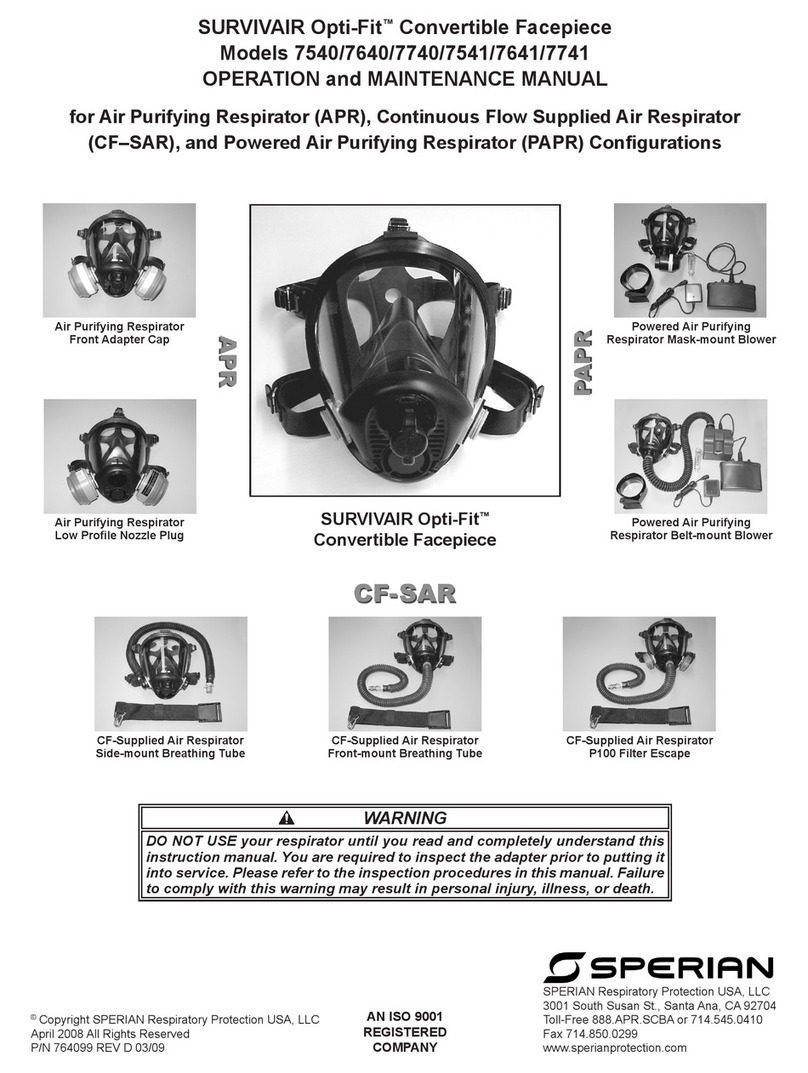
Sperian
Sperian SURVIVAIR Opti-Fit 7540 Operation and maintenance manual
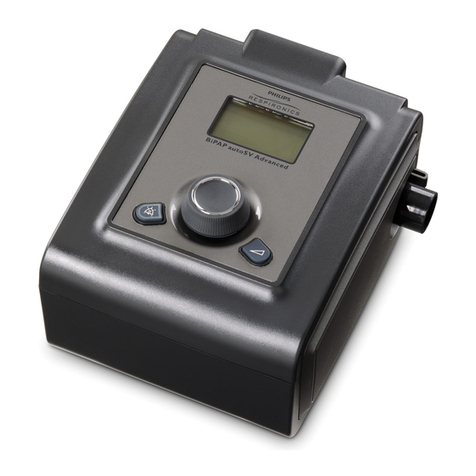
PHILIPS Respironics
PHILIPS Respironics BiPAP autoSV Advanced System One user manual

IRUDEK
IRUDEK Iru002 instructions
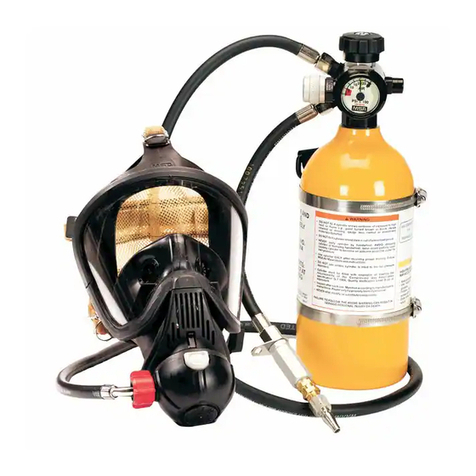
MSA
MSA PremAire Cadet 15M Maintenance procedures
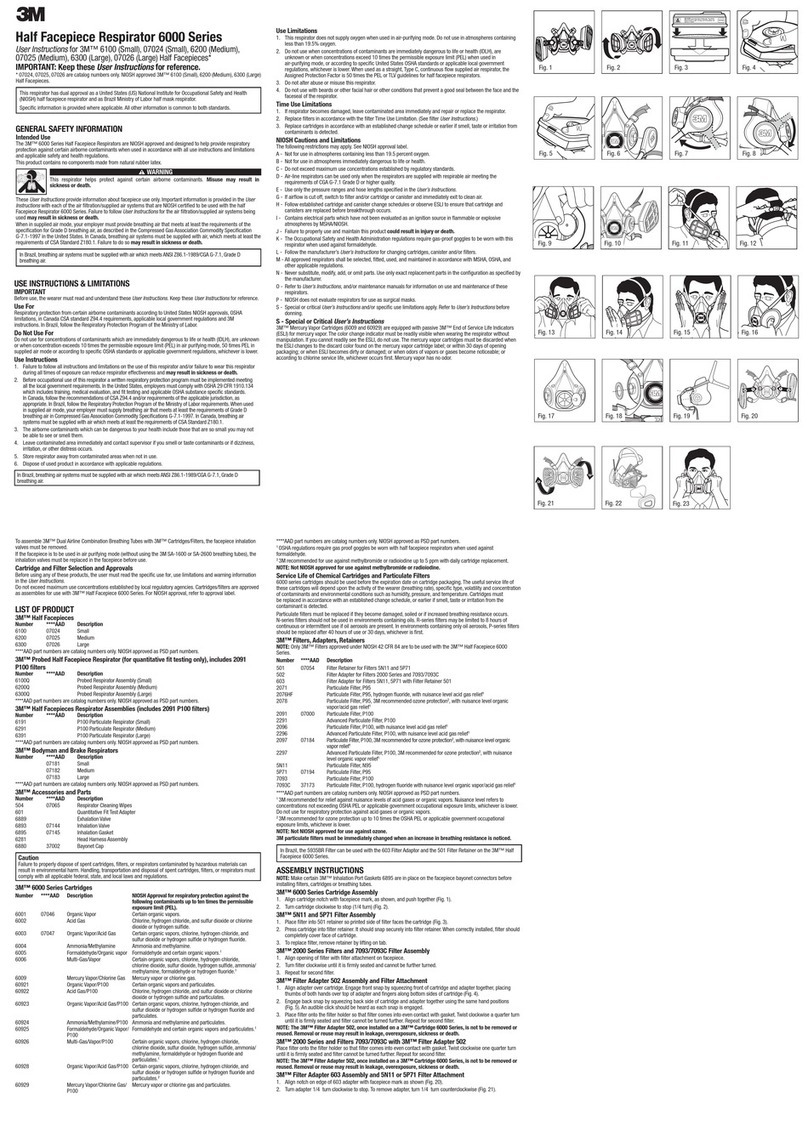
3M
3M 6000 User instructions
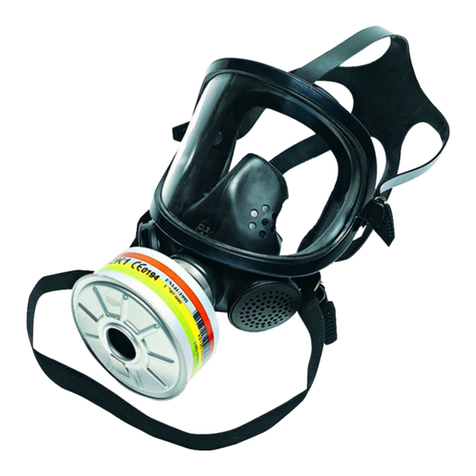
Honeywell
Honeywell PANORAMASQUE instructions
